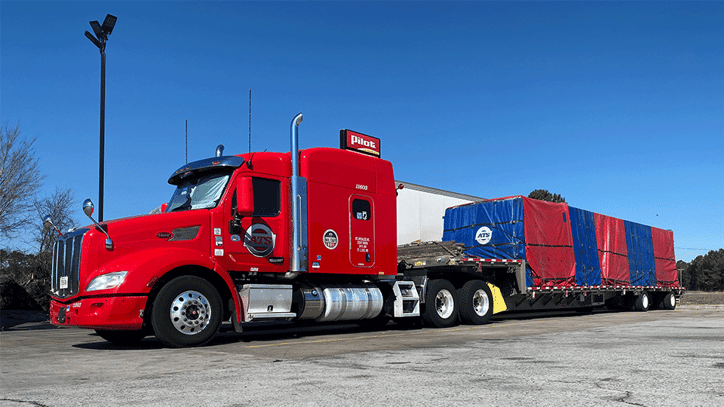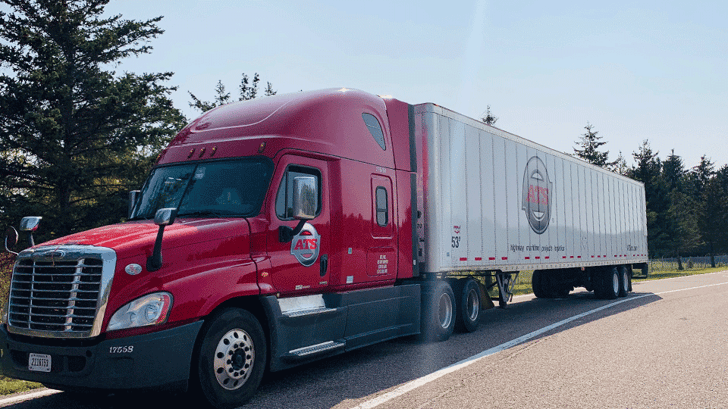
Managing a transportation supply chain isn’t easy. With inbound trucks to schedule and outbound shipments to oversee, things can quickly get out of hand without proper relationships, understandings and planning.
The volatile, unpredictable nature of the transportation marketplace only exacerbates this further. With so many variables to consider and few tools to lean on for assistance, it’s understandable if you feel overwhelmed at certain points in your role.
Did you know that for trucking companies, meeting pickup/delivery appointments is universally more difficult at certain times of day and easier at others? More importantly, do you realize the profound budgetary impact understanding and planning based on this information can have?
Here at ATS, we’ve been a central piece of North American freight transportation since 1955 — helping companies, like yours, meet their goals, deadlines and customer commitments all the while.
Over this period, we’ve noticed the impact appointment times have on carriers, shippers and consignees alike. And, although many companies understand how lead time impacts the rates they receive, few consider how appointment times affect them.
In this article, you’ll learn how morning, mid-day, afternoon and evening/nighttime appointments respectively affect transportation companies and truck drivers and, in turn, the rates you’re given.
Below, you’ll find information about:
- The importance of your appointment times
- Morning pickup/delivery appointments
- Mid-day pickup/delivery appointments
- Afternoon pickup/delivery appointments
- Evening and nighttime pickup/delivery appointments
The Importance of Your Appointment Times
As a company with a supply chain to manage, you understand how difficult it can be to strike a balance between reliable service and competitive pricing. Without controlling the things you can, and planning for the inevitable bumps accompanying each load, your transportation costs may rise quickly.
Your appointment times — the periods within which you schedule inbound shipments and outbound departures — are one of the few things you can control.
By planning your appointments with the right set of understandings — how your length of haul impacts a driver’s hours of service (HOS), what carriers think about when planning their trucks, how the time of day impacts a driver’s transit capabilities, etc., — short and long-term cost savings can be achieved.

How Do Hours of Service Regulations Factor In?
As it currently sits, the rules and regulations governing the total time drivers can spend “on-duty” — coined their HOS — are:
14-hour daily limit: For-hire commercial motor vehicle operators are only allowed to be on duty for 14 hours within a 24-hour period of time. This 14-hour window includes all breaks, delays, driving and rest periods a driver experiences while on-duty and begins as soon as they start their truck to begin a “shift.”
11-Hour Driving Limit: A driver is not allowed to drive any more than 11 hours within a 24-hour timeframe. Every 11-hours of drive time must be followed by a 10-hour consecutive break.
60/70-Hour Limit: Truck drivers may not log more than 60 hours of drive time within seven days or 70 hours in eight days. Drivers only become “on duty” again once they have taken a consecutive 34-hour break.
These HOS regulations are why it’s absolutely crucial to consider the role rigid appointment times play in your supply chain.
Work with your carriers on this. Ask them what appointment times make the most sense for your shipments, based on their current HOS realities. Doing so will help you save some money and develop the kinds of relationships you deserve.
Note: it’s important to account for the distinctly human centerpiece of the transportation industry (the fact that truck drivers are not machines) — limiting their ability to take their dollars further.
Morning Pickup/Delivery Appointments
Pickup and delivery appointments that occur between 5 and 11 a.m. are generally classified as “morning” appointments. For truck drivers — who are highly conscious of their hours of service clocks — morning pickup and delivery appointments are often highly coveted.
You see, in the pursuit of maintaining a relatively consistent schedule, many drivers prefer to start their day in the morning — receiving or dropping a shipment during the early hours.
In these scenarios, truckers can show up to an appointment, burn no more than two hours of their clock being loaded/unloaded and continue with their day — either hauling freight onward or heading to their next pickup.

As a shipper, morning pickup appointments make the most sense when you have a length of haul ranging between 400 and 500 miles. These shipments allow drivers to pick up in the morning, transport freight to its destination and get unloaded — either that afternoon or early the following morning — the perfect scenario for an over-the-road driver, which can lead to cost savings.
Mid-Day Pickup/Delivery Appointments
Appointments that occur between 11 a.m. and 2 p.m. are some of the most difficult for trucking companies to arrange. This is especially true of delivery appointments within this time frame.
You see, in observance of their hours of service (which represents the daily period within which drivers can make money) truckers like to work as expeditiously as possible.
By their very nature, however, mid-day appointments make this more difficult. You see, more often than not, aligning these requirements to their schedule requires a driver to sacrifice at least some of their on-duty service hours.
Take, for example, a driver arriving at a 1 p.m. delivery appointment for a shipment that traveled 300 miles. Since the majority of semi-trucks travel at an average speed of 55-65 miles per hour, it’s likely that this driver was loaded the previous day.
Additionally, factoring in a relatively conservative timeframe of one hour for unloading, that driver will leave this facility no sooner than 2 p.m. — giving them a measly two hours (many shippers close up shop around 4 p.m.) to arrive and be loaded at their next pickup location.
In scenarios like this one, where servicing a load makes it more difficult for drivers to maximize their HOS, shippers are charged more. As such, if you’re hoping to save money on your transportation costs, steer away from mid-day delivery appointments for loads traveling distances between 300 and 500 miles.
Asking a driver to pick up your shipment between 11 a.m. and 2 p.m. can also be challenging. In order to do so, your driver will have to be emptied previously — either at an early morning delivery or by delivering the evening prior. As a shipper, this will often limit your capacity options — particularly on short notice.
That said, offering your freight as a mid-day option for drivers planning to deliver in the morning may help you shave some dollars off your rates. When unloading in the morning, many drivers like to pick up their next load as soon as possible, take their ten-hour break and continue on the following morning.
Once again: your situation will vary, making it important to structure your appointment requirements based on how your needs align with the capabilities of your carrier network. Communication will go a long way here.
Related: 4 Out of The Box Ways to Save Money On Your Freight Rates
Afternoon Pickup/Delivery Appointments
Afternoon appointments — those landing between 2 and 5 p.m. — are another option many shippers employ.
Offering your freight as a landing spot for drivers looking to finish out their clocks for the day — by picking up your load — can be a great option, particularly when your length of haul exceeds the distance truckers can cover in one day.
If your load’s length of haul falls between 500 and 600 miles, an afternoon pickup — allowing drivers a bit of drive time before shutting down for the day — can make a lot of sense.
In these instances, carriers can get a truck to your facility (a truck that was likely unloaded that morning) get that truck loaded with cargo and on its way toward a rest area to shut down for the day, before transporting your freight the following morning.

Afternoon deliveries, marking one of the final things a trucker does for the day are also beneficial when a shipment’s length of haul matches up correctly. Freight that picks up at 7 a.m. (for example) and needs to travel to a destination 300-400 miles away can be perfectly suited for an afternoon delivery appointment.
The same can be said for long-haul shipments that loaded the previous afternoon (600 miles) or morning (1000 miles).
Evening and Nighttime Pickup/Delivery Appointments
Sometimes, companies schedule pickup/delivery appointments after regular business hours.
On the pickup side, evening appointments, typically occurring between 5 and 8 p.m., can be attractive to trucking companies and their drivers.
It’s not uncommon for truck drivers to prefer hauling at night — particularly for loads that make this possible (like legal open-deck or dry van freight). Reduced traffic and quiet roadways often allow truckers to put on a few extra miles after sundown.
As such, if it makes sense for your loading crews and shipping deadlines — and your carrier has drivers willing to make it work — scheduling an evening pickup needn’t be avoided.

On the flip side, loads that have an evening/nighttime delivery appointment can sometimes be more challenging and require proper oversight. To avoid issues (like price hikes) on these shipments, make sure to communicate whether onsite parking will be allowed at your facility.
Often, following an evening delivery, drivers seek to shut down for the day to avoid overextending their HOS, which can lead to fines and infractions. Offering drivers a place to rest following an evening/nighttime delivery will make servicing these loads far more attractive to trucking companies, which are sometimes hesitant to send trucks into them.
Related: Reduce Your Freight Rates By Doing These 8 Things Truckers Enjoy
Should You Avoid Appointments Entirely?
Now that you have a better understanding of how pickup and delivery appointments get more, and/or less, challenging at various times of day, make sure to plan based on these understandings. Most importantly, work with your trusted carriers to figure out which appointment times will work best for both of you. Doing so will help you save money and meet your deadlines going forward.
That said, holding appointment times for drivers — regardless of the time of day — isn’t the right solution in every situation. First-come-first-serve (FCFS) loading/unloading procedures are another tactic many shippers employ
Could FCFS fit your business and supply chain better than any appointment ever could?
To answer this question, here is an article outlining everything you need to know about FCFS. Give it a read today and ensure that your logistical procedures are the absolute best fit for your company.
Finally, if you have any questions about how ATS can help you meet your goals, maintain your deadlines and take your shipping dollars further, let’s connect. We’re always happy to help great companies, like yours, become the supplier that always delivers for their customers.



